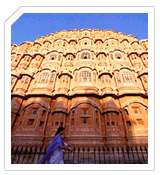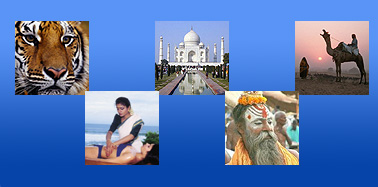|
 Capital of Rajasthan also known as Pink City, surrounded on all sides by rugged hills crowned with forts and enclosed by embattled walls. Visit to City Palace which now houses a museum containing rare manuscripts, paintings, and an armoury, the observatory with a sundial 90 ft high, the museum is amidst the Ram Niwas Palace gardens founded in 1876 with a large collections of antiques, the Palace of Winds, a landmark of Jaipur made of Pink Sandstone and of unique design. Capital of Rajasthan also known as Pink City, surrounded on all sides by rugged hills crowned with forts and enclosed by embattled walls. Visit to City Palace which now houses a museum containing rare manuscripts, paintings, and an armoury, the observatory with a sundial 90 ft high, the museum is amidst the Ram Niwas Palace gardens founded in 1876 with a large collections of antiques, the Palace of Winds, a landmark of Jaipur made of Pink Sandstone and of unique design.
Amber 12 Kms from Jaipur, lies Amber with an old palace overlooking the lake at the entrance to rocky mountain grove, built in 17th century, the palace is a distinguished specimen of Rajput Architecture.
Sightseeing at Jaipur -
City Palace : The magnificent City Palace is in the centre of the Pink City of Jaipur, enclosed by high walls and set amidst fine gardens and courtyards. Since it was built by Jai Singh in 1728 it has been the principal residence for the Maharajas of Jaipur and the successive rulers have each added to it. The major attractions in the palace are - Chandra Mahal, Mubarak Mahal, Diwan-I-Khas, Dilkusha Mahal, Moti Mahal, Sheesh Mahal and Krishna Mahal, all of which are adorned with exquisite colours and paintings.
 Amber Fort :
Situated on the crest of a hill seven miles north of Jaipur is Amber, capital of the Kuchwaha Rajputs from 1037 to 1728. The city-palace is protected by towering outer walls, a further wall runs for miles along the hills surrounding the palace. For many, the most memorable part of a trip to Jaipur is the journey up the palace ramparts, through a succession of vast gates, on the back of a painted elephant – Maharaja style. Inside are the ruins of a once great palace, a wonderful example of Rajput architecture, with Mogul influences. Amber Fort :
Situated on the crest of a hill seven miles north of Jaipur is Amber, capital of the Kuchwaha Rajputs from 1037 to 1728. The city-palace is protected by towering outer walls, a further wall runs for miles along the hills surrounding the palace. For many, the most memorable part of a trip to Jaipur is the journey up the palace ramparts, through a succession of vast gates, on the back of a painted elephant – Maharaja style. Inside are the ruins of a once great palace, a wonderful example of Rajput architecture, with Mogul influences.
Hawa Mahal : (Palace of the Winds) Hawa is Jaipur’s most remarkable attraction. Built in 1799, it is situated on the edge of the City Palace complex overlooking one of the city’s main streets and was constructed to offer the women of the court a vantage point, behind stone-carved screens, from which to watch the activity in the bazaars below. The five-storey building is shaped like a crown adorning Lord Krishna’s head and contains over 900 finely screened windows and balconies.
Reaching Jaipur -
Air : Well connected by air to Ahmedabad, Aurangabad, Calcutta, Delhi, Jodhpur, Mumbai, Udaipur.
Rail : Well connected to Delhi, Ajmer, Ahmedabad, Abu Road, Jodhpur, Chittorgarh, Indore, Bikaner, Udaipur by its own railhead.
Road : Jaipur is well connected to all major towns of India by road.
|


